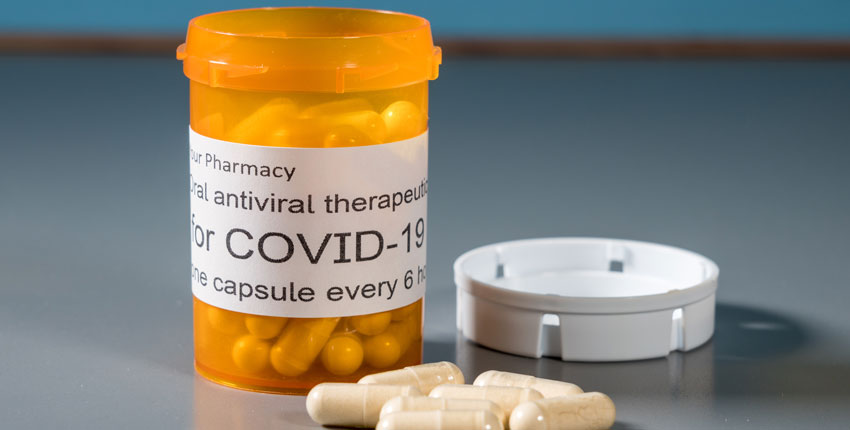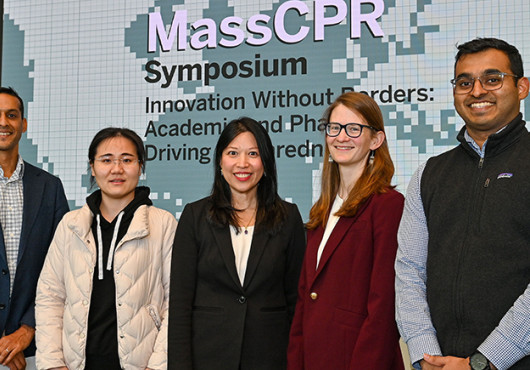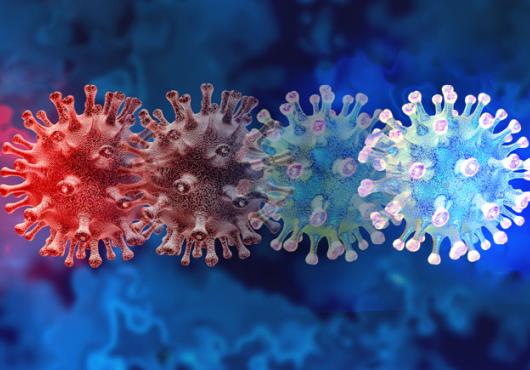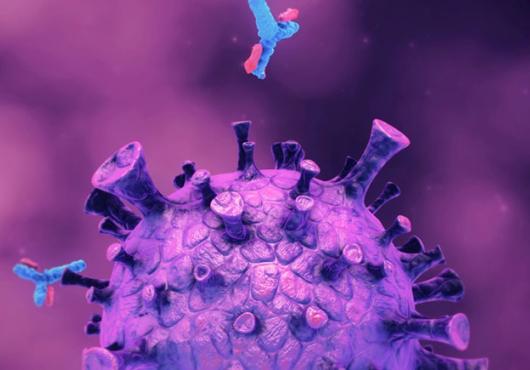
This article is part of Harvard Medical School’s continuing coverage of COVID-19.
Even as the COVID-19 pandemic continues into a third year, questions remain about how to most effectively treat people infected with SARS-CoV-2. Scientists have pursued a range of treatment options, rapidly churning out research in an effort to keep pace with a virus that has quickly morphed from one variant to the next.
Scientists from the Harvard Medical School-led Massachusetts Consortium on Pathogen Readiness, or MassCPR, on May 10 discussed the status of the pandemic, including rising cases and the current landscape of therapies for COVID-19. Experts included:
- Jonathan Abraham, HMS assistant professor of microbiology; infectious disease specialist at Brigham and Women’s Hospital
- Amy Barczak, HMS assistant professor of medicine; infectious disease specialist at Massachusetts General Hospital; investigator at the Ragon Institute of MGH, MIT and Harvard
- Jacob Lemieux, HMS instructor in medicine; infectious disease specialist at Mass General; viral variants program co-lead for MassCPR
- Jeremy Luban, professor of molecular medicine, biochemistry, and molecular pharmacology at UMass Chan Medical School; viral variants program co-lead for MassCPR
- Adrienne Randolph, HMS professor of anaesthesia; critical-care specialist and immunobiologist at Boston Children’s Hospital
Harvard Medicine News: What are we currently seeing in terms of COVID-19 numbers in the United States?
Lemieux: The reality is that things are not going well at the moment. I certainly thought that we were in for a reprieve after the devastating omicron wave, and that was the case until a few weeks ago when case counts started creeping up. Initially, it was just in a few places, but the trend has continued and expanded geographically. The Northeast is definitely ahead of the rest of the country, but we’re now seeing cases rising in the upper Midwest and across the entire United States.
In Massachusetts, cases are slowly but persistently rising along with the test positivity rate, but what’s really concerning is that the hospitalization rates are also going up. I and many other people had expected that as treatments become more available and as vaccinations become more widespread, we would see a decoupling of case counts and hospitalizations, and we have to a large extent, but it hasn’t been the complete decoupling we had hoped for. Our excellent wastewater surveillance program in Massachusetts also indicates that cases are starting to rise again, suggesting that we’re going to see this continued increase in cases for at least another week or two, and probably longer.
We don’t fully understand what’s driving this, but novel variants seem to be a big part of it. In New England, we’re now dealing with a nearly complete BA.2.12.1 epidemic. In South Africa, the BA.4 and BA.5 subvariants have almost fully outcompeted the BA.2 lineages that were circulating beforehand, and are causing a significant fifth wave and an increase in hospitalizations. The bottom line is that there is actually a lot of activity in terms of novel variants, and we don’t yet fully understand the relative contributions of these variants, other immunological factors, and behavior in generating these surges.
HMNews: What does this rising COVID-19 case count tell us about what to expect moving forward?
Lemieux: It doesn’t seem like a good sign, in the sense that there’s already a lot of immunity in the population. Many people have been infected with BA.1 on top of being vaccinated, so a very small fraction of the population doesn’t have some degree of immunity to SARS-CoV-2—and yet there’s a significant outbreak that is accelerating. It suggests that we’re not in the endemic phase, and it also raises a lot of important scientific questions about what’s going on.
These novel variants are not very different from what came before them—they are only a few amino acids different, so these are minor changes in the virus genome—and yet they are behaving categorically differently. These minor changes are associated with increased fitness and transmissibility of the virus, as well as substantial rises in case counts in the population. It’s almost like having somebody who runs a 2:30 marathon change their sneakers and all of a sudden runs a two-hour marathon. It doesn’t make sense and it needs to be explained. We need to investigate further.
HMNews: Switching gears a bit, what have been some of the challenges in developing effective treatments for COVID-19?
Barczak: Monoclonal antibody therapies that bind to the spike protein and neutralize the virus were among the first treatments to emerge, and they’re very effective, but they’ve also been the quickest to develop resistance. Many of those, at least for the moment, have dropped out of our group of medicines that we can use.
Antiviral therapies that block different features of viral replication have emerged as quite important at this point, including remdesivir, which was available early, and now Paxlovid. If we want to stay on top of COVID-19, we need more drugs that target more aspects of the viral life cycle to be able to outpace viral evolution, especially given that resistance will inevitably emerge.
Even as we use the drugs that are now available, we still don’t know very much about them—something that is illustrated by the reports of Paxlovid rebound. Paxlovid is now the first-line therapy for people who are at high risk of doing poorly from COVID-19, and in the initial studies it lowered the risk of hospitalization or death by 89 percent in these individuals. But as it rolls out clinically, we are seeing a subset of individuals that get Paxlovid start to feel better, and then start to develop new symptoms 10 to 14 days later.
As clinicians have been trying to interpret the data that exist to guide our understanding of what to do, we realized that there is a lot we don’t know. For example, how often is rebound occurring? Is it associated with drug resistance? Can individuals with rebound transmit COVID-19? Are some individuals at higher risk of rebound? Does antiviral therapy change the response to the virus? These are questions we need to study.
One issue is that clinical trials that test drugs are typically using very defined outcomes and well-defined populations, but real world application is more complex. Emerging therapies to date have mostly been studied as individual agents, and they have not been studied in head-to-head comparisons.
The reality is that populations are changing in terms of their baseline immunity and vaccination levels, so it’s hard to know how to compare antiviral agents. So how do we get the data that we need to make better use of our therapies? And how do we make better efforts towards moving from pandemic to endemic? We need to be able to quickly test new variants against all existing therapies, and we need to expand the way we study these agents by looking at them in combinations, in head-to-head comparisons, and in immunosuppressed populations that are the most likely to benefit but also the most complicated to treat.
HMNews: What is the utility of Paxlovid at this point in the pandemic, when many people have some immunity?
Luban: There are many reasons why it makes sense to continue using a drug like Paxlovid, even in people who are vaccinated. It can reduce the likelihood that the infected individual is going to have complications from the virus. It can also shorten the period of time during which that person can transmit the virus to other people. As far as I know, Paxlovid works quite well against all of the variants that we’ve seen so far.
It’s important to remember this coronavirus infection is acute—it’s a short duration—and so the kinds of issues that exist for treating people with HIV long-term are very different, at least in terms of giving the virus the opportunity to mutate and select viable drug resistance mutations.
Abraham: I would add that I think it’s very important to find the right patients to treat with these kinds of drugs. We also need to figure out the time window in which these drugs are effective, and test whether or not the agents can be used to prevent infection.
There’s been success with monoclonal antibodies to prevent infection, but when Paxlovid was studied as a means to prevent infection in household contacts of people with COVID-19, it didn’t work. Thus, I think massive distribution of Paxlovid to prevent infection wouldn’t be advised, but as a drug it works quite well as a treatment for COVID-19.
HMNews: Speaking of monoclonal antibodies, is there still a role for them in treating COVID-19 as new variants emerge?
Abraham: The first set of monoclonal antibodies that were developed for COVID-19 have largely lost activity against omicron, so now we’re left only with bebtelovimab, the latest agent to be approved under the FDA’s emergency use authorization for treatment, and Evusheld (tixagevimab-cilgavimab), an antibody cocktail that is used only for prevention.
The monoclonal antibodies that we know bind and are active against omicron in cell-based assays tend to do a good job at preventing hospitalization and death when given early. There have also been major advances in terms of how monoclonal antibodies are delivered. They can now be given through subcutaneous or intramuscular injections rather than as an infusion at a hospital. I think we now have a better understanding of how to use monoclonal antibodies to treat COVID-19.
For me, the lesson to be learned from bebtelovimab is that perhaps the best approach to therapeutic antibody discovery is one in which you have a library of antibodies available. Phase 1 testing could already be done on those antibodies so that they can be safely administered, but you’d then roll out the antibody that is active against a new variant based on a limited number of studies done in vitro.
Currently, whenever a new variant emerges, scientists race to very quickly figure out which antibodies work in cell-based assays. Creating a library of antibodies would give us a head start, as opposed to always trying to play catch-up, so we’re better prepared to quickly identify and deploy effective monoclonal antibodies when the next variant arrives.
HMNews: What about COVID-19 prevention and treatment in children?
Randolph: On the prevention front, for vaccine-eligible children vaccination remains the best option to minimize risk of infection and serious disease. We looked at antibody responses among vaccinated and unvaccinated children and we saw that in children who were infected with some of the earlier strains of SARS-CoV-2, natural infection did not protect as well against the omicron variant as the vaccine, which has been shown in adults.
Vaccination is also important in pregnancy. We’ve published data showing that if you vaccinate the mother during pregnancy, the baby has a decreased risk of being hospitalized for COVID-19 complications in the first six months after birth. There is also evidence that vaccination can lower the risk of multisystem inflammatory syndrome in children with COVID-19, based on evidence we and others have published. The odds of this complication go down with vaccination.
In terms of treatment, Paxlovid is currently authorized for use in children 12 years and older or in those weighing at least 40 kilograms. There is also an ongoing safety trial of Paxlovid in children who can take the medication by mouth, so this is being studied relatively rapidly.
The monoclonal antibody bebtelovimab is also authorized for children 12 years and older who weigh more than 40 kilograms. However, due to scant clinical data, it is authorized only for patients who have no other treatment options. Aside from remdesivir, there are no other FDA-approved COVID-19 drugs for children. Many teenagers got really sick, and some died from COVID-19, especially during the delta surge in the South.
Physicians have generally used drugs and treatment strategies approved for adults to treat children of all ages with very severe disease. The other high-risk population is infants under six months of age. There is really nothing studied in this population. Remdesivir is approved for infants down to 28 days, but not approved for neonates yet as it is still under study in that group.
For children who do develop multisystem inflammatory syndrome, the preferred treatment is intravenous immunoglobulin and/or steroids to reduce inflammation. The World Health Organization has put forward steroids as first-line treatment for this condition. In the United States, we still put forth that intravenous Ig plus steroids will more rapidly reverse cardiovascular involvement in patients with the most severe disease. However, intravenous Ig is not available everywhere, so it’s good that steroids have also shown benefit in these patients. The goal, of course, would be to prevent this complication with vaccination.





